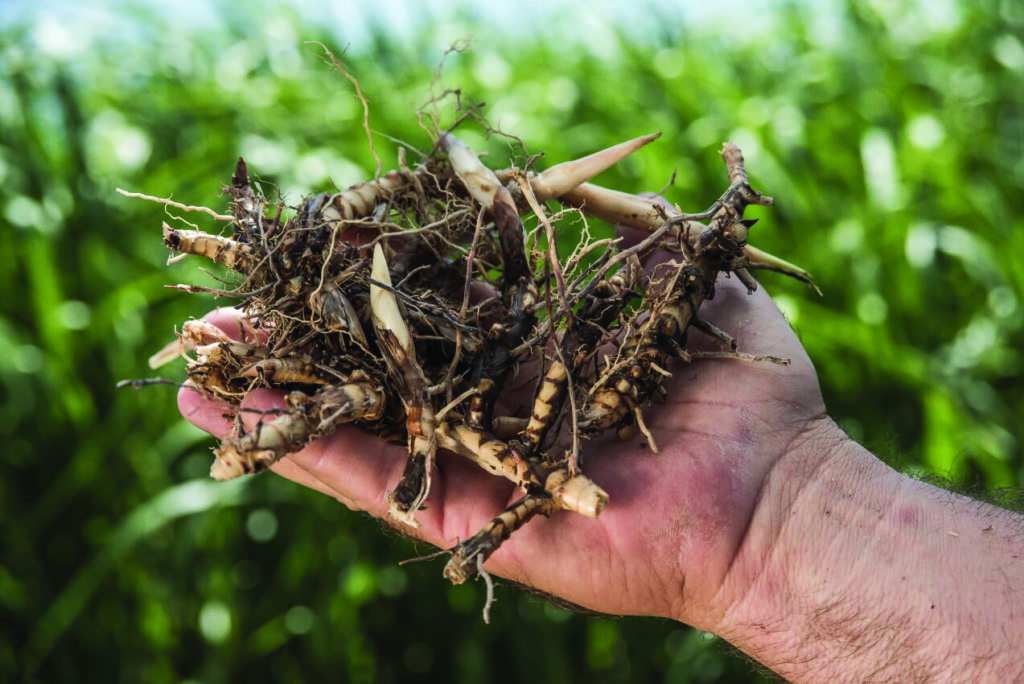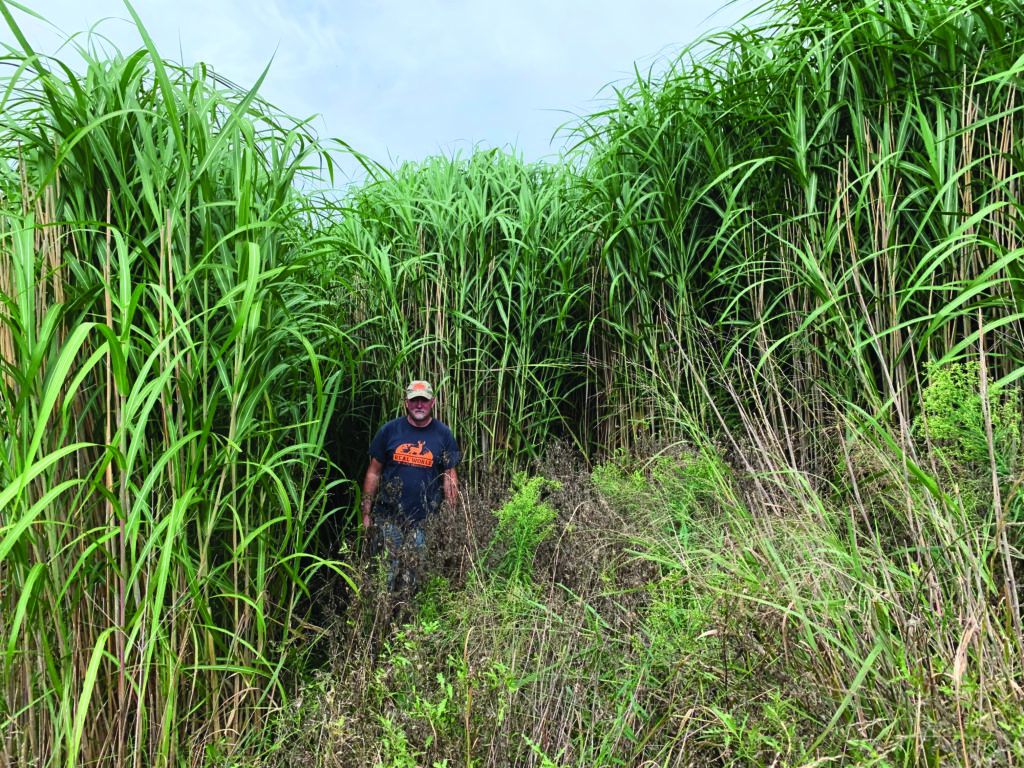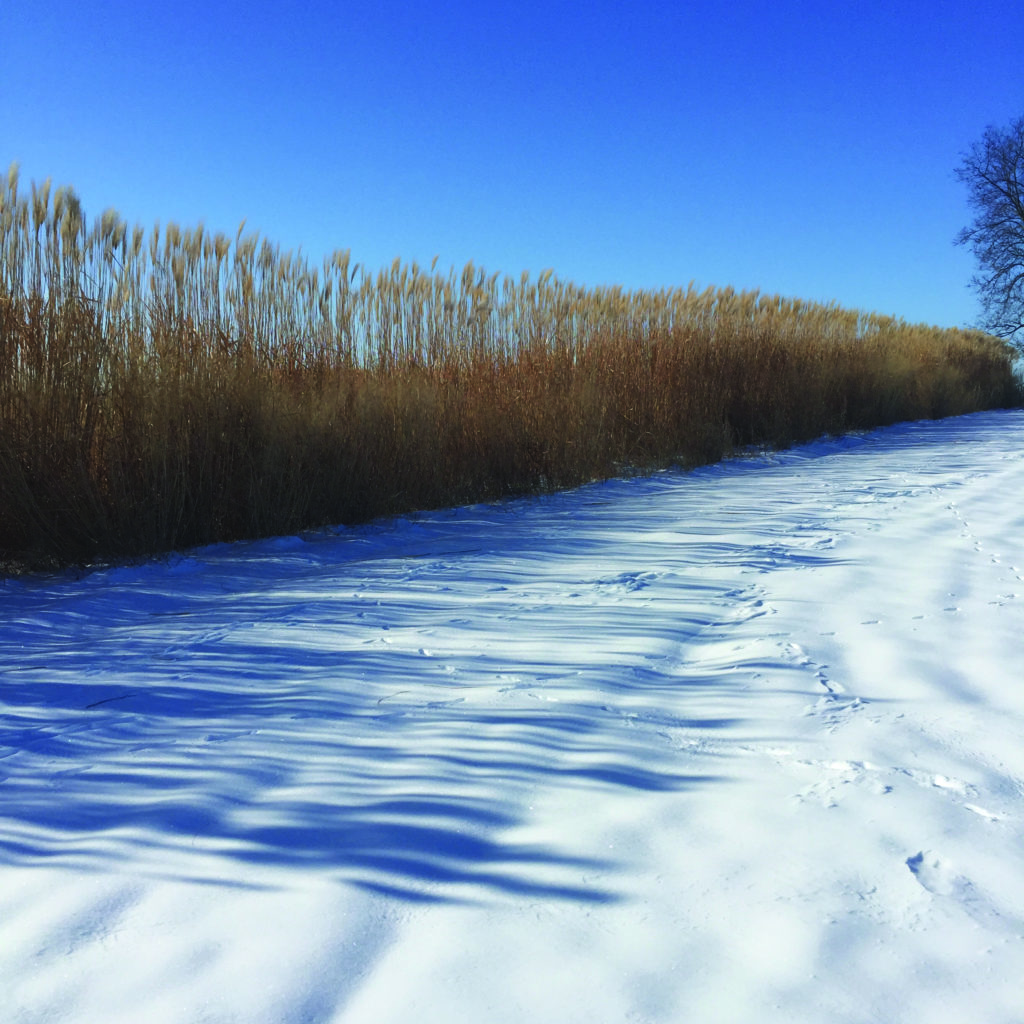In recent years, more whitetail land managers have discovered the many uses of giant miscanthus grass for creating quality deer habitat. Even so, many are not yet on board, and some have never heard of this plant.
Giant miscanthus is a tall grass native to Asia. The miscanthus genus includes about 20 species of grasses. This is important to note, as some of those species can be invasive and should be avoided. For this article, I’ll refer only to Miscanthus giganteus (giant miscanthus), which is a sterile hybrid and not invasive.
Giant miscanthus was primarily developed for the bio-fuel industry because of the huge tonnage of plant material it produces and that can be harvested per acre. This grass easily grows higher than 12 feet in decent soils and has bamboo-like stalks that stand up well to high winds and snow. This makes it ideal for screening roads or entrance paths to stands and hunting blinds. Giant miscanthus is a perennial that’s relatively new to America, so the longevity of a planting is not well known. However, some plantings in the United States are 30 years old.
Getting Started
Many land managers have no prior experience with it, so I’ll go through the basics of planting, growing and maintaining giant miscanthus. My goal is to help you have a successful giant miscanthus planting, as they require significant up-front costs and labor investments. Remember, however, this up-front cost is a one-time expense. Planting giant miscanthus might seem like a questionable financial decision at first, but when you amortize the cost through several years compared to annual screens, it’s really cheaper and provides much better results. When you factor in the labor savings of planting an annual screen versus a one-time giant miscanthus project, it becomes an easy decision for many.
Miscanthus is not propagated via seeds but by planting small pieces of root called rhizomes, which are living plant material. Buy rhizomes from a reputable source to ensure they are fresh and have been properly handled and stored. Rhizomes need to be kept moist from the time of harvest and through storage and shipping until planting time.

When planting for screening, rhizomes should be spaced 18 inches apart in rows that are 18 to 24 inches apart. To create a good screen, plant three to five rows of giant miscanthus. You can plant the rhizomes with a shovel, but I’ve found a tree-seedling planter pulled behind a tractor is much faster and easier. No matter the planting method, the ideal planting depth of the rhizomes is 3 to 5 inches.
Giant miscanthus will tolerate a wide variety of soil types, but as with most plants, the richer and more fertile the soil, the better plant production will be. Ideal soil pH for giant miscanthus is 5.5 to 7.5. This plant does not like “wet feet,” so don’t plant it in extremely wet areas. However, adequate rainfall and moisture encourages vigorous growth. Sandy or dry soils are not ideal, and growth will be less in those conditions.
It’s very important to select a good planting site. I tell folks to think of miscanthus as corn. Miscanthus requires the same growing conditions as corn to thrive — lots of sunlight, no competition from other plants (weeds) and adequate moisture. What would happen if you tried to plant corn along a road in the woods? The same thing will happen with miscanthus in that setting. Any plant a whitetail land manager uses has specific requirements to flourish, and miscanthus is no different. Choose your planting site wisely.
Preparation of the planting site is extremely important. You must start by killing all vegetation at the site. This means using herbicide, as tilling or working the ground will not kill the roots of many competing plants. They will grow back from the roots and severely hamper the growth and establishment of miscanthus. I prefer to kill the vegetation at the planting site during the fall ahead of a spring planting, but that’s not an absolute requirement.
READ: TOP 14 FOOD PLOT SEEDS AND EQUIPMENT FOR 2021
Planting should be as early as possible in spring, but the rhizomes will remain dormant until soil temperatures reach about 60 degrees. When it’s time to plant and the site is free of vegetation, I start by working the soil as deep as possible with some sort of equipment. Again, that’s not totally necessary but it loosens the soil, which helps the rhizomes grow new roots and establish quickly. After the site is ready, simply use your planting method of choice to get the rhizomes in the ground at the proper depth and spacing.
Weed Control, Fertilization and Maintenance
Weed control is extremely important, and the better job you do controlling weeds, the better and faster your giant miscanthus will reach its full potential. Start by applying a pre-emergent herbicide, such as atrazine, Dual or Harness Xtra. These are essentially corn herbicides that also work well with miscanthus. Spray one of those chemicals over the planting site after the planting is complete. Use the rate recommended on the label for corn. A pre-emergent herbicide works to prevent weeds from growing. This will greatly cut down on subsequent work to control weeds.

Through time, the pre-emergent herbicide will lose its effectiveness, and weeds will start to appear. When the weeds reach about the same height as the young miscanthus plants, you can spray them with 2-4D, again at the rate recommended on the label for corn. 2-4D will not harm miscanthus or other grasses. It will only kill broadleaf weeds. If unwanted grasses become a problem, you’ll have to deal with those manually. Or, you can use the herbicide Quinclorac on some grass weeds, such as foxtail. The key with all weeds is to spray them when they are young and small instead of waiting until they are bigger and more mature.
I’m often asked about fertilizing miscanthus. I strongly urge people to not fertilize it the first year. Instead, let those young plants become well rooted and established. After that, a moderate dose of nitrogen can have a positive effect on plant growth. Urea is a granular form of nitrogen that can be purchased in bags at most farm stores. Honestly, in most soils, fertilizing is not needed.
People also ask how long it takes giant miscanthus to establish or what to expect for growth the first year. I simply relate my experience with a few plantings on my property, which were done through several years. The first year, you can expect each rhizome to produce a plant with one to four stalks that are 4 to 8 feet tall. The second year, plants will produce four to eight stalks that are 8 to 12 feet high. At the end of the third growing season, most of my giant miscanthus plants had at least eight stalks and were 12 to 15 feet tall. This was on pretty good soils with average moisture and fair weed control the first year. I know of plantings that were not nearly as good and some that were better.

After you’ve established a good stand of giant miscanthus, how do you maintain it? I burn my giant miscanthus in late winter about every two to three years. This gets rid of old dead material and lets new growth flourish without obstacles. I realize some situations won’t allow for burning, and in those cases, I would try to mow down old stalks in late winter every couple of years.
Misconceptions
Let’s address a huge concern I’ve heard many times regarding giant miscanthus: Some say it spreads outside of where it was planted. As mentioned, giant miscanthus is a sterile plant, so it does not produce seed. That’s why it can only be propagated by planting rhizomes. Other miscanthus species are invasive, and you should never plant those. Often, folks just hear the word miscanthus and assume that giant miscanthus is as invasive as other miscanthus species, but that’s not true.
Each giant miscanthus plant will only spread about 4 inches per year through its roots. There’s no chance of it spreading throughout your property. I’ve had miscanthus on my property for almost 10 years, and the only plants there are the ones I planted. If you need to kill the miscanthus you plant, you can easily do so with common farm chemicals such as glyphosate.
Giant miscanthus has transformed my property, and I continue to find new ways to use it. If you have not yet planted giant miscanthus, maybe it’s time to see what you’ve been missing.


